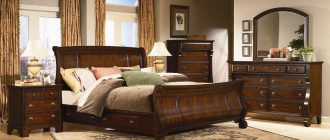Collectors, who exhibit certain examples of furniture as French, English or American, frequently lower their opinions of the merit of such pieces on learning that they actually originated in Germany. Other German designs are accepted as Dutch, Flemish, French Provincial, Iberian or Italian. Collectors as a whole, not to mention institutions exhibiting antique furniture, are unaware of the different schools which were followed, and the many designs evolved throughout the independent German states.
If all works of art were to be assessed according to quality of design and craftsmanship, the finest German furniture would be ranked with important French and English specimens. While many examples do receive such regard in Franee, the situation is different in England and America. When an important specimen in an English collection is proven to be of German origin, a lawsuit may result because of the drastic reduction in market value.
The pecuniary appreciation of English furniture exceeds that of Continental furniture produced in more or less related patterns. In instances when Continental examples have been sold for about the same prices as somewhat similar English productions, it has been held that the purchasers received less than full value. Therefore, an exceptionally fine lacquered or veneered piece, far exceeding English costs and skills in manufacture, but executed in Saxony or Brandenburg, is not valued as highly today as a supposedly comparable English specimen. Nobody can deny the existence of quality and artistic merit in such German examples. Since they have been deemed worthy of association with other fine pieces of English origin, their equal or greater value may eventually be recognized.
German authorities readily acknowledge indebtedness to French and English designs. However, they take great pride in their own contributions, which may be seen in more typically native productions. In major German towns statutes governing the service of furniture apprentices and journeymen were as rigidly enforced as those effective in France and England. Apprentice training consisted of several years in a master’s shop, followed by over a decade as a journeyman. Many journeymen worked in France, Italy and England. To qualify as a master it was necessary to produce a piece de maitrice, as in Paris, designed and made by the applicant alone.
Master cabinetmakers often cast and finished their own decorative appliques, modeled after those of France and England, sometimes with added elements of native design. Such resourcefulness saved Dresden ateliers considerable sums which might otherwise have gone to France and England. Sculptors and painters also collaborated with cabinetmakers, supplying carved, painted and gilded effects, as had been done in Italy. Various influences, such as geography, temperament, political conditions and the work of neighboring craftsmen, resulted in a great diversity of talents and materiel in the design and construction of fine furniture.
In the southern German states craftsmen, influenced by the bravura of the Italians, introduced their spirited embellishments in examples which were further inspired by the French. Talent in the western and central states was largely influenced by France and The Netherlands. In northern sections stimuli came from Holland, France and England, while some interchange of ideas occurred between North German and Scandinavian areas.
The vitality of acquired ideas, added to the best native skills, resulted in a continuous development of techniques in leading manufacturing centers, which were later spread to many smaller towns. During the seventeenth century a number of craftsmen had already surpassed the accomplishments of French and English cabinet makers, although, in general, refined designs and accomplished working methods were developed after the middle of the eighteenth century. At this time, while French craftsmen were merely repeating established designs, the more sophisticated of the German variations displayed a greater originality. Similarly, popular native themes frequently added interest to repeated English designs.
In the castles and smaller homes of the noble and wealthy families great sums were lavished on architecural features and specially made furniture. The architect, Joseph Effner, mentor of Francois Cuvillies, was responsible for important commissions of this type in Bavaria, notably in Munich, which was one of the finest and handsomest towns in Europe during the early eighteenth century. Francois Cuvillies was taken into the service of the elector of Bavaria, sent to Paris to study under the masters there, and became one of the leading interpreters of the Rococo style, along with his countrymen, the Slotz brothers, and the Italian, Meissonnier.
Johann Michael Hoppenhaupt and F. X. Haberman were the principal exponents of the native Rococo school affecting designs to the north. Renditions of their projects in Brandenburg often appear as close approximations of French creations in furniture and interiors, executed with imagination and with considerable delicacy and grace.
Furniture skills existent in Berlin and Potsdam during the middle of the eighteenth century, at such workshops as were maintained by the Spindlers and Melchior Kambly, could well rival those of Paris. While favored contours often present divergencies from the more usual French outlines, they appear as welcome contrasts, and possess decided vigor and interest, accompanied by highly skilled work in marquetry or lacquer decoration, and rhyming appliques of gilded bronze.
During his reign, King Frederick William built numerous fine houses for the inhabitants of Potsdam. His son, Frederick the Great, contributed still further to the embellishment of this town after ascending the throne in 1740. Various apartments in the Potsdam palace and at Sanssouci, which were then furnished, have been widely illustrated and amply portray the prevailing mode. In adjoining Berlin, the larger and more ancient capital city, Frederick II was even more liberal in his rebuilding projects. It was here that French and English influences were shared in designs chosen from among those offered by Hepplewhite, and by publications of less authoritative nature.
Of the many German ebenistes who were accepted masters in Paris during the reign of Louis XV, and particularly in that of Louis XVI, Oeben, Riesener, Beneman and Schwerdferger designed and worked with full acceptance of the Gallic spirit. A considerable number of their countrymen, however, retained native characteristics. These are apparent in the work of Wolff, Schlichtig, Rubestock, Grenevich, Joseph (Joseph Baumhauer) and Shiller. It is apparent that German cabinetmakers, and craftsmen who specialized in supplying marquetry, were more assured of success in Paris than were chair-makers.
Adam Weisweiller is also representative of the German-trained craftsman who executed refined designs distinguished by lack of heaviness and floridity. He is acknowledged as one of the most brilliant ebenistes of his time. Weisweiller is reputed to have been born in the town of Neuwied, adjoining Coblentz, and to have received his technical training in the atelier of David Roentgen.
David Roentgen (1743-1807) came to be known as le plus celebre ebeniste de l’Europe after taking over the establishment which had been founded by his father in Neuwied. This event took place in 1772, and marks a change from the more strongly characteristic German designs of the elder Roentgen. David traveled widely in Europe, accompanied by vans containing selected examples of Neuwied productions. It has been said that on a first trip to St. Petersburg he secured the interest of Catherine the Great through his resourcefulness in arranging, overnight, for a clock in a secretaire to commemorate a Russian naval victory that had just occurred at Tschesme. (The date of this victory is given by Russian historians as occurring in 1770, so that the story must be discounted; and David’s popularity with Catherine II was subject to her vagaries. However, between 1783 and 1791 he visited St. Petersburg frequently, supplying the Empress with numerous examples of work turned out at Neuwied.) Many of Roentgen’s pieces were made expressly for such commercial enterprises, and therefore could be dismantled so that they would take up the least possible van space.
A first visit to Paris in 1774 proved so successful that subsequently David Roentgen maintained a warehouse there. His furniture, however, was always produced in Neuwied. It is claimed that he also opened warehouses in Berlin and Vienna. He was not a member of the Paris ebenistes corporation until 1780, and as a foreigner was free of the rule governing the stamping of furniture with an identifying pontil mark. In some instances, however, the important and finely executed productions of the Neuwied factory are distinguished by the initials, “D.D.,” or other identification in marks or inlays.
David Roentgen apparently owed his business success in part to his exceptionally handsome appearance and ingratiating manner. Of equal significance were the elaborate fittings and mechanical devices built into his furniture, and the skills of his craftsmen in carrying out the techniques favored in Neuwied, as in the marquetry work of Chretien Krause and Michael Rummer, and the mechanical ability of Johann Roetig. Assistance to other cabinet shops in North Germany, Paris and Copenhagen, was rendered by David, his technicians and his brother, George Roentgen. It is claimed that Chippendale’s Director was used by Abraham Roentgen, father of David, after his return from working in Galway, Ireland, previous to 1750. John Okely, an English youth, was apprenticed to the elder Roentgen, while in turn he sent one of his own craftsmen to London for training.
Investigations attempting to determine the origin of the New England blockfront designs have long ignored the typically native designs produced in southern and central German states through the second quarter of the eighteenth century, and later in states as far north as Mecklenburg and Holstein. Once these German and Danish blocked forms were adopted here, craftsmen of different nationalities collaborated in their production. This is indicated by hints of English, Irish or Dutch structural techniques. However, German origin is further substantiated by the frequent appearance of twin moldings on the upper edges of pine or poplar drawer sides, a definite Germanic detail.
Marked English influence, which appeared in these states during the middle of the century, was centered in Hanover and the numerous adjoining duchies, principalities and free cities, in Mecklenburg, Pomerania and the vicinity of Danzig. This influence appeared in furniture approximating Early Georgian designs, which were followed until 1770 or later. In Brunswick, however, the furniture brought over by the royal English bride of Prince Karl Wilhelm Ferdinand, in 1764, is said to have caused considerable attention and admiration, and to have been regarded as the first of such examples seen there.
More distinct English influence was felt after 1770, and in a wider variety of forms. This is noticeable in designs copying the true Chippendale style, following the general adoption of straight legs. From this time on English designs were copied in the North, in Brandenburg, Anhalt, Weimar and Saxony. In the vicinity of Berlin, rooms were furnished in the style of Sir William Chamber’s chinoiserie creations, and in the mode developed by Robert Adam, with perhaps the closest approximations in mirror frames and balancing wall treatments. Wedgwood plaquettes were supplied in copies made at Cassel. Angelica Kauffman, a favorite artist of Robert Adam, not only portrayed German and Danish nobility, but her classic figural studies were lent to the prevailing decor.
Chippendale and Adam styles were followed in chairs and settees, occasional tables, tables with fret galleries, chests of drawers, cabinets and secretaries. The evolution of native designs, influenced by the same Italian and French sources that were drawn upon in England, produced many “Louis XVI-Adam” effects, and some of those which approached Chippendale forms.
The Berlin Academy of Art, in 1777, on determining which of the ebenistes working there, according to the native, French and English schools, might be qualified for academic honors, selected as suitable only those -who followed the English school.
Designs from Hepplewhite’s Guide were particularly favored in Germany as a source of patterns for backs of seat furniture. These were sometimes selected from plates which had greater appeal to local tastes than to those of English chair-makers or their patrons. Sheraton’s remarks concerning Continental interest in English furniture designs no doubt referred specifically to the use of English designs in Germany and in Denmark. There was even greater evidence of this interest when a group of Sheraton’s own designs were published at Leipzig in 1794.
The skills which German craftsmen displayed in carrying out Georgian designs were recognized by George Smith in The Cabinet-Maker and Upholster’s Guide, with its introducted dated in 1826. After eulogizing the ability of the English craftsman, and disparaging that of the French ebeniste in regard to construction and design, his second paragraph under Cabinet Furniture is devoted to praise of German cabinetmakers working in England before, and during, his time. “In this place we must not omit to mention another race of artizans: viz. the Germans, as being ingenious in almost every branch of mechanical art placed under their hands: they possess the grand essential toward producing good work, viz. that of patience, if they are not altogether so quick and fanciful as the French on that which relates to design. Some years back many of these artizans worked in several of our cabinet manufacturies, but have since emigrated almost all of them into the musical establishments of Messrs. Broadwoods, Muzio Clementi, Stodart and others.”
English designs were introduced even more widely in local periodicals, such as the Magazin fur Freunde des guten Geschmackes, the Journal fiir Manufaktur-Fabriken and the Journal des Luxus und der Maden. In addition, craftsmen had access to imported English furniture, which was displayed and sold in local warerooms, and ordered directly from London by the nobility and more affiuent citizenry.
A new method of decorating furniture and smaller objects, in lacquer, had been discovered in 1758 by Johann-Heinrich Stobwasser (1740-1829), who afterwards founded a successful manufactory at Brunswick, and in 1772 opened a branch in Berlin. He produced furniture, coffrets, snuff boxes and other small objects in wood and papier-mache, designed after both the native and English tastes. These were decorated in his lacquer finish and painted by the finest artists available. In executing a royal order to copy a table which had been ordered from London, he succeeded so well that his work was considered superior to the original.
Mirror frames of the more formal carved and gilded designs were, in general, elaborately rendered throughout Germany up until the Classic period. During the Rococo era gilding was sometimes replaced by a grained finish, simulating mahogany or walnut. Outside influences stemmed from Italy and France. While English influence was present during the Classic period, this did not affect these formal designs to any great degree, although a few pieces have been accepted as true Adam and Hepplewhite specimens. Original makers’ labels were affixed to some mirror backs during the Classic period, but these have generally been removed.
Mirror frames veneered in walnut and mahogany, with gilded wood or gesso ornament, were produced in North Germany, and in neighboring Danish areas, where Altona, a principal center in this production, adjoined Hamburg. Designs in these two areas were thus closely related, and were influenced by similar external motivations.
It is apparent that shipping activities were in part responsible for various relationships in “Queen Anne” and “Georgian” types of frames, which were often produced later in the century than the periods with which they have come to be associated. Styles that might suit American tastes, in current demands for looking glasses, would in all likelihood be seen, or sought out and acquired, by Yankee merchants in these sections. Supercargoes of ships from Philadelphia, Salem or other American ports, destined for Denmark, North Germany and Russia, may have displayed examples picked up in Ireland or England at way points. Or the reverse may have occurred on return voyages, when it is recorded that (Danish) eglomise mirrors were sent home from Bilbao, a stopping point for ships bound farther southward and to the East.
Principal styles appearing in these veneered frames, generally associated with English and Irish designs, have been accepted by a native expert as characteristic of North German work. While it has not been possible to prove all of these attributions, they may at least serve to indicate a wide development, along adjoining coasts of the North and Baltic Seas, of mirror frames with variously shaped or fret-scrolled contours, and with architectural pediments.
Designs which are definitely eliminated from consideration as English are often accompanied by structural features employed in the North German and Danish areas and which are also similar to those found in some Irish work. This circumstance may indicate a transfer of such skills to Ireland, and it prompts additional caution in forming final judgments regarding origins of these mirrors.
Opinions regarding the origin of such frames, and their backboards, have been largely based on the type of pine in which they appear, often claimed as originating in New England or Pennsylvania. As a result, various Danish and North German frames have been attributed to these American states. Examinations of the frames and backboards usually reveal more knots than American craftsmen would have permitted, though the pine itself is closely similar to that used by American craftsmen.
From Brunswick in North Germany, Christian Wilmerding came to New York City in 1783 and soon opened a looking-glass store. In Philadelphia John Elliott and his sons operated several stores in which looking glasses were sold. Today both of these merchant families are considered as having been sufficiently qualified in cabinetwork, carving and gilding to have executed veneered and parcel gilded mirror frames. The Elliotts dealt in second-hand merchandise, clothing patterns, thread, stockings, desk articles, casters, books, jewelry, buttons, painters’ supplies, lumber, drugs, medicines… and looking glasses. Wilmerding changed his store location four times between 1785 and 1795, during the same time acting as secretary of the German Society and also serving in the Militia. After a return trip to Germany he continued as a merchant for a while, and then transferred his talents to a brewery. It is remarkable that his trade card, on which he did not claim the manual skills bestowed by museum authority, prominently featured shipping cases… and also musical instruments, which until now such authority has not credited to his hand.
There are interesting research problems for Elliott and Wilmerding enthusiasts in America: to prove that a veneered and parcel-gilded pier mirror frame was ever made by any member of the Elliott family, or by Wilmerding; to trace the course of ships, advertised as making deliveries of Elliott mirrors, to their stopping points; and to determine whether Wilmerding’ s mirrors came from North Germany or the British Isles.
American shipping interests in Germany were responsible for Hamburg’s development as a leading port. This city was the largest and wealthiest of the ancient Hanse towns, with a population of over one hundred thousand persons at the close of the eighteenth century. The famous Derby family of Salem was represented in Hamburg by Rucker and Wortman, agents mentioned in connection with such historic cargo ships as the Grand Turk.
On calling at the seaports of northern Europe, supercargoes of American ships found that the production of mirror plates had reached truly advanced states. Here they augmented purchases that had been made in Ireland and England. Continental sources, however, are completely overlooked in the literature on American furniture. In Blue Book-Philadelphia Furniture, the author, William MacPherson Horner, Jr., after painstaking researches in an attempt to establish the presence of a similar industry here, could offer no definite facts. Singularly, a belated reference to Hamburg, Germany, closes this most important work, with recognition only of our export trade. Commerce is effected through the exchange of commodities American ships were not simply freighters, they were carrying on trade. If it is finally recognized that they delivered furniture to Hamburg, Germany, the closing words of Homer’s book, it is indeed strange that return cargoes have heretofore been given no consideration.





